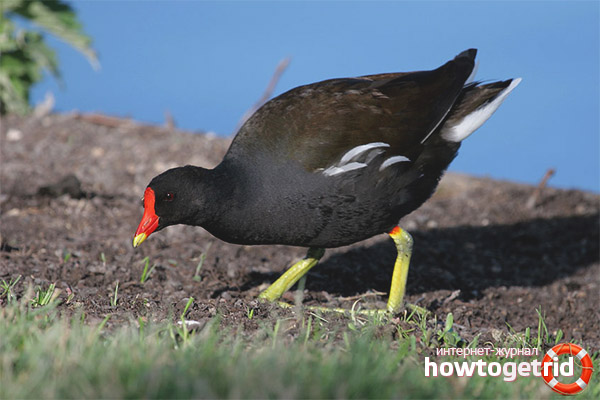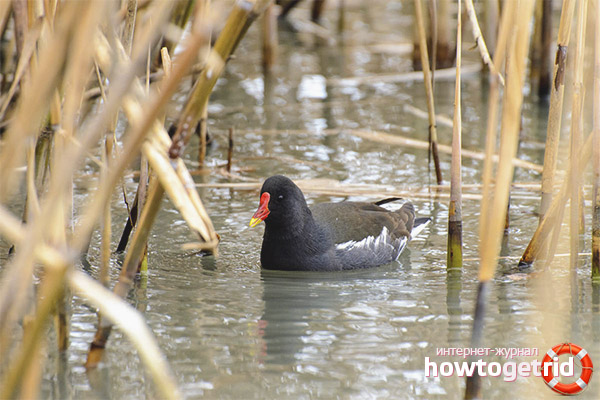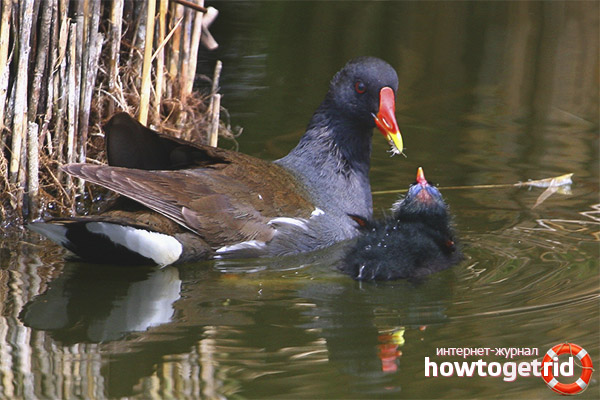The content of the article
Moorhen bird is also called swamp or water chicken. It dwells in wet forbs. This bird flies quite rarely. From a distance, the color looks ordinary, but upon closer inspection, it is very interesting and unusual. In the fall, they are actively hunted.
Description
The bird lives in ponds or on swampy shores. The body length of the moorhen is about 31 cm. It weighs about 200-500 g. The wingspan of this interesting bird is about 195 cm. The plumage has a blue color with stripes on the sides. The plumage is light on the stomach. Brown and olive individuals are sometimes found. On the wings, the plumage is dark gray. During molting, the breasts and feathers at the ends turn white. Some parts of the body become variegated. They molt in autumn and winter.
The beak is short, red. At the tip there is a green and yellow color. The legs are strong and long, the claws are slightly bent. There are no membranes between the fingers, which distinguishes the bird from many other individuals that live near water bodies.
Representatives of different sexes are not very different from each other, and young individuals have a lighter plumage. The difference between the male and the female in the body length is about 2.5 cm. On the breasts of young individuals, the plumage is gray and the undertail is white. There is no red spot on the forehead.
The chicks hatch black, with some greenish tint on their backs. They have rare fluff on their heads. The beak is orange. At the end is yellowish.
general characteristics
When the bird is concentrated, from afar you can hear something like “chickens”.
In the spring and at night it screams “cre”.
In flight, screaming quietly and unanimously.
Representatives of this species rarely rise into the air, while not scattering. Usually they fly only directly and quickly. It is in this manner that hunters distinguish this species from other birds. In flight, the bird’s neck is stretched forward. And her paws are set back. Moorhen land vertically, sitting on tree branches. It flies very well among trees, bending around branches.
Although the bird lives near water bodies, it does not really like water. Spends more time in thickets near the coast. It can move very quickly on land, bending its legs.
Habitat
You can meet this bird on almost all continents, with the exception of Antarctica and Australia. They also do not live in the northern latitudes of Eurasia and North America.
Depending on where the birds live, they can be settled or migratory. The populations inhabiting the territory of Western Europe do not fly away for the winter. Birds living in the center of Asia and in the south of the African continent are also sedentary.
Moorhen, living in eastern Europe, in the Far East and in the western part of Siberia, are migratory. They winter in India and northern Africa.
Moorhen, living in North America, live in the south and east of the United States, as well as in Mexico. In South America, they live in the north and in the center of the continent. Their habitat reaches Peru and Argentina.
Birds fly away for wintering to warmer areas if the pond near which they live freezes for the winter. If the pond is not covered by ice, they remain at the nesting sites all year round.
Molting
Shedding begins at the age of a year. This happens in the fall or in the middle of summer. In young individuals, the plumage changes only partially.
Adults shed during the breeding season. During molting, small and large feathers change. Flywheels also drop out. As a result, the bird temporarily loses its ability to fly.By winter, the plumage changes to a new one.
Nutrition
In the diet of moorhen there is both plant and animal food. They eat aquatic and terrestrial insects. Their favorite food is larvae, spiders, various mollusks.
An insect bird most often pecks from reed stalks. Submerging the head in water, the bird can get insects. From the vegetation, they eat shoots and berries growing near the nesting sites.
Breeding
Representatives of this species become sexually mature at the age of one year. Even if there are a lot of moorhen in one territory, couples nest separately from others. On one small pond, most often only one pair of moorhen lives. While in larger bodies of water several pairs of these birds can live. But they equip the nests at a distance of about 80 m from each other. In addition, each pair near the reservoir has its own plot, where they feed without entering foreign territory. The nest is quite large in size. It significantly exceeds the dimensions of the bird itself. During the incubation period, the diameter of the nest can be about 21-24 cm. And when the chicks appear in it and begin to trample it, the diameter increases by 5-10 cm. The height of the nest is usually about 15 cm.
The nest consists of one material. Most often, moorhen builds it from old leaves and roots of reeds, sometimes it also uses reeds. Occasionally, birds can build their house from sedge. The whole nest is loose, and the bird lining the tray with thin, moist leaves. When they dry, they stick together. As a result, the surface is smooth.
Depending on the habitat of the birds, the nest may be located on a tree, reed or reeds. It can even be on a stump. But it is always located in flooded areas. A bird swims towards him through the water.
If the nest of moorhen is located in the reeds or reeds, it then touches the water, then rises above its surface. If the water level in the river changes dramatically, the bird usually builds a nest on trees at a height of 2-3 m.
At one time, the female lays 6-12 eggs. More can happen only occasionally. In appearance, the birds of the sultanka are similar to eggs. But in moorhen they are somewhat smaller in size. Some of them are pale green, some are yellow with a touch of rust. In addition, the color of the egg can be any that is intermediate between the two described shades. Sometimes on the main background there are spots of different sizes. They can be brown, gray or light.
During the summer, the moorhen brings up chicks twice. The first time takes place in April-May. The second - at the end of June and throughout July. During this period, you can hear the voice of the male, which in other months of the year is mostly silent. They scream at dawn and in the dark. The voice is heard not only from the thicket, but also from the air when the bird flies. A nest with an egg can be seen from April to August. In August, there are practically no eggs.
Chicks hatch from late May to mid-summer. The female lays one egg a day. She begins to incubate when almost all the eggs have already been laid. Almost all the time the female incubates them. A male can come to her aid only occasionally. But during hatching and when the chicks are still small, both parents are near the nest to protect them and take care of the offspring. Hatching lasts about 3 weeks.
As soon as the chicks are born, they can immediately perfectly swim and even dive.Those that emerged from the first masonry are forced to quickly adapt to an independent life, since parents are engaged in a second brood. When they grow half the size of an adult, they begin to disperse along the reed beds, and return only to rest. Chicks from the second clutch are together until departure.
Moorhen Hunt
Among hunters, some birds are especially popular. And moorhen is one of such representatives of birds. Hunters love her for her beautiful appearance and the taste of meat. From it you can cook excellent dishes directly in nature or at home. You can cook a very good broth from meat or just fry it on a fire. Spices for roasting on fire are recommended to be used in a minimum amount. Smoke gives meat a wonderful aroma.
Video: moorhen (Gallinula chloropus)












Submit